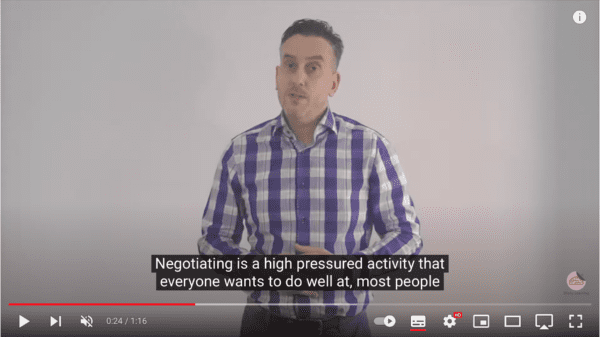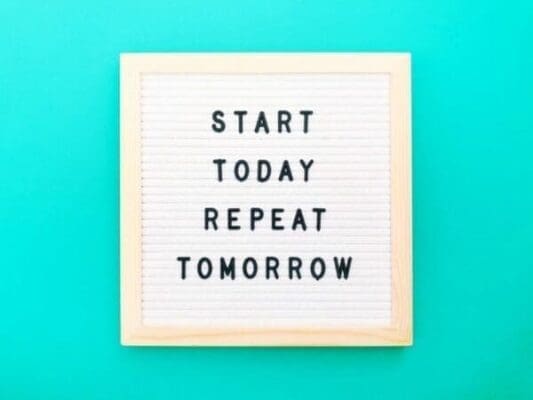Negotiation Effectively Requires Confidence in Negotiation. One of People’s Greatest Fears is Negotiating.
Having to get a great deal for their company, their boss, or themselves, and not wanting to let themselves down. Not knowing how to prepare, no tools to use, and not having confidence in negotiation, amounts to anxiety and trepidation at having to negotiate, leading to ways to not negotiate. This is normally achieved by emailing instead or quietly accepting the first offer.
Confidence in negotiation is key because if the other person can sense that you are nervous, and give the impression that you don’t know what you are doing, they’ll probably exploit the situation for their own gain. There are a number of ways to improve your confidence when negotiating. Each requires a change in behaviour that will only come through practice, but it will come.
#1 – Prepare, Prepare, Prepare
Most people either don’t prepare or prepare using Powerpoint slides. Neither will achieve the preparation that leads to confidence in negotiating. Over the last 20 years of training people to negotiate, I have learnt that preparation, and more importantly, a structured method of preparing is one of the keys to unlocking the door to becoming a great negotiator.
We developed the ‘Squaredance’ one-page template many years ago to help people. It is completely free and like most tools that are really useful, it is very simple. Preparation involves you working through the squaredance template until you have prepared your approach to your negotiation.
Find out about negotiation preparation and download the squaredance template.

#2 – Begin with the End in Mind to Improve Your Confidence in Negotiation
Stephen Covey, the author of the international best-selling book ‘The Seven Habits of Highly Effective People,’ said in habit #2 – ‘Begin with the End in Mind’. In essence, Stephen was advocating that all things are created twice; once in the mind and then once in reality.
If we consider what we want to achieve from the negotiation, then focussing on that end game is important to help us achieve our objectives. If we don’t begin with the end in mind it is a little like Usain Bolt waiting in the blocks for the gun to fire, and thinking, ‘I’ll run fast’, or a better thought is, ‘9.58 seconds – that’s what I will achieve.’
Be clear on your outcome. What do you have when you have finished the negotiation? Then, work towards making it happen.

#3 – Use the Wonder Woman Pose
Amy Cuddy is a social psychologist, bestselling author, award-winning Harvard lecturer, and expert on the behavioural science of power, presence, and prejudice. In her Ted Talk Amy shares that your body shape may shape who you are. With 21 million views this 21-minute video is well worth watching because it will help you add another edge to your confidence when negotiating.

Sticky Learning ® is 7 times more effective than 1-day training courses. Plus, you will get a Chain of Evidence proving your Return on Investment. Discover soft skills training that changes behaviours long term.

#4 – Influence Better with the Word-on-Head Technique
Influencing techniques can be seen as adding very little until you accept that the difference between a person accepting and rejecting a deal can be down to a change in your tone, some different words, or how you come across with your body. ‘Marginal gains’, as the Olympic British Cycling Coach suggests.
Read our article about difficult conversations which details the word on head technique and how using that influencing technique can help you make a difference.
#5 – Role Play
If you have seen the film ‘A Few Good Men,’ you’ll have heard Jack Nicholson say his Code Red reply to Demi Moore – “On the record, I tell you that I discourage the practice in accordance with the NIS directive. Off the record, I tell you that it’s an invaluable part of close infantry training, and if it happens to go on without my knowledge, so be it. I run my base how I run my base. You want to investigate me, roll the dice and take your chances. I eat breakfast 80 yards away from 4000 Cubans who are trained to kill me. So don’t for one second think you’re gonna come down here, flash a badge, and make me nervous.”

Roleplay is a lot like Code Reds, no one likes them but they are an essential tool in training. Role-playing your negotiation will make a huge difference to your actual live negotiation because you will have already ‘lived it’ and we all know that the second time is always much easier. Plus, with the right roleplay opponent, they will put you in situations that you can then consider how to get out of in the real thing. Just like when Sam Weinberg was role-playing the witness in the boxing scene with Daniel Kaffee (Tom Cruise).
Remember, it’s better to sweat in training than bleed in battle.
#6 – Negotiate How You Want to
Many people believe that they need to think on their feet. They do not. This is because you can’t. You cannot teach yourself to think quicker, or prepare for every scenario. However you can have strategies to give yourself those few vital seconds of thinking time. These 7 strategies will help. I suggest learning one or two to help you get that space to breathe:

- #1: ‘Please Tell Me More’
- #2: ‘So, You are Asking…’
- #3: <Silence>
- #4: ‘I Do Not Know’
- #5: <Deep Breath>
- #6: ‘I’d Like to Better Understand…’
- #7: ‘Please Can You Repeat the Question…’
Read more about each of these 7 strategies of thinking on your feet to help improve your confidence in negotiations.
#7 – ‘A Bad Workmen Blames His Tools’
You need a few tools to help you negotiate effectively. Not lots. Just a few that you can use well and that suit your personality. There is one tool that is a must-have – the ‘If you…, then I…’ tool. This 1-minute video will explain more:

Beyond these tools, please read through our list of 50 negotiation techniques.
#8 – Ask Questions to Improve Your Confidence in Negotiations
In my experience, the best negotiators are not those that bang their fists on the table, shout, and generally act mean, but those that seek to understand. Which is habit #5 of ‘The 7 Habits of Highly Effective People’ – Seek first to understand, then to be understood. By asking questions, you are not giving anything away or conceding, you are just seeking to understand what they need. Yes, they’ll want a better price, but what else do they need, and what sort of price reduction; money off, money off immediately, money off if XYZ happens, money off because they want to give you a larger volume – the devil can be in the detail.
Imagine you are buying a second-hand car from a dealer and you are at the forecourt. You happen to be admiring the 2-seater sports car. The salesperson comes over and starts telling you about the previous owners, how well it runs, and more patter. If she’d only started by asking what you need, she’d have realised that you have 4 kids, and an SUV is what you need.
Questions help you understand what they need, and then you can tailor your proposal to achieve what they need. The alternative is what most people find themselves doing – ignoring the first two stages of negotiating; preparation and exploration – then going straight to the proposal where they find themselves in a deadlock.

#9 – Trick Your Mind into Thinking You’re Not Nervous
A psychology student recently shared a video on how to trick your brain into thinking that you are not nervous. She’s done all the research, tested this simple theory and found it to work. Well worth a 2-minute watch or click the image below:

#10 – Learn from the Experts with External Training
I’ve heard about many negotiation training courses from our competitors; ‘They made her cry’, ‘They were sooo tough’, ‘Hardest thing I’ve ever done’. This, to me, is not training. You shouldn’t be made to feel less. A learning environment should be conducive to learning. We don’t learn through fear, or certainly, we don’t need to.
The objective of learning is to change behaviour. We achieve this by training Learners based on learning science. For example, you didn’t learn to drive by someone shouting at you, as you tried to fumble with the gearstick, watch the road, and indicated left. You learnt through something called ‘spaced repetition,’ which simply means that you did a driving lesson, then waited a while (Normally a week), and then did another and repeated the process until you changed your behaviour.

Spaced repetition is just one of the learning sciences we used to create our unique training method – Sticky Learning ®.
#11 – Eight Methods of Resolving a Conflict
There are 8 ways to resolve a conflict. Negotiating is just one. A powerful one. There are 7 others.
#12 – Use the Advanced Version of the Squaredance
In #1 above we talked about the Squaredance method of preparation. The advanced version of this technique is that once you have completed the squaredance for yourself, then complete the template for your opponent. This will significantly help your approach to your negotiation because you’ll be able to ‘get into their head/s’. By doing this, you can think as they do, predict what they will ask, what they will want, and how you will then respond.
Summarising How to Improve Your Confidence in Negotiation
Any of the above strategies, or a combination of two, will significantly improve your confidence when negotiating. In turn, this will improve your approach to your negotiation, which will then increase your chances of achieving the outcome that you want to achieve.
Take a look at our negotiation infographic.
For even more useful content on negotiations, check out our ultimate guide on negotiation skills.




